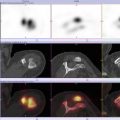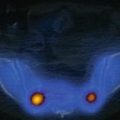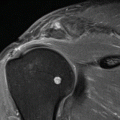© Springer-Verlag Berlin Heidelberg 2015
Andor W.J.M. Glaudemans, Rudi A.J.O. Dierckx, Jan L.M.A. Gielen and Johannes (Hans) Zwerver (eds.)Nuclear Medicine and Radiologic Imaging in Sports Injuries10.1007/978-3-662-46491-5_2525. Injuries in the Pelvis, Groin, Hip and Thigh
(1)
Sports Orthopedic Research Center – Copenhagen (SORC-C), Arthroscopic Center, Department of Orthopedic Surgery, Copenhagen University Hospital, Amager-Hvidovre, Denmark
Abstract
Pelvis, groin, hip and thigh injuries in sports include multiple, complex and long-standing conditions, causing great frustration among athletes and sports practitioners. Pain in these regions may originate from many anatomical structures such as the muscle, tendon, ligament, cartilage or bone. Acute groin and hamstring injuries are the most frequent injuries in the different football codes, where especially hip and groin injuries are very prevalent problems. Moreover, the recurrence rates of these acute injuries are very high and a major problem during the rehabilitation and return-to-sport phase. Basic understanding of the anatomy and biomechanics and its relation to specific injuries in this complex region is important to make relevant clinical choices concerning clinical examination and diagnostic imaging. Hip, pelvis and trunk muscles are all constantly involved in most sports activities contributing to a considerable amount of both eccentric and concentric work, including fast changes between these work forms. These muscles are highly important but also at risk of sustaining an injury. Acute muscle-tendinous injuries in the hip and groin region occur in the adductor muscles (usually the adductor longus), the hamstring muscles (often biceps femoris) and the quadriceps muscle (often the rectus femoris), often during forceful eccentric contractions such as accelerating and decelerating movements, kicking and extreme positions. In the athlete with long-standing hip and groin pain symptoms often seem to be contradictory and confusing. In up to 1/3 of patients with long-standing hip and groin pain, multiple causes can be found. The symptoms associated with an intra-articular hip problem can include pain, catching, locking, clicking, feeling of instability and giving way. A labral/cartilage injury in the hip commonly refers pain to the anterior groin. However, anterior groin pain is not specific for this injury but can be due to other intra-articular pathologies and/or extra-articular pathologies. Important differential diagnoses including stress fractures, referred pain or nerve entrapment and abdominal or gynaecological disorders are other possible causes of pain in these regions and should therefore also be considered.
25.1 Introduction
Pelvis, hip and groin injuries in sports include multiple, complex and long-standing conditions (Bennell and Crossley 1996; Bradshaw et al. 2008; Holmich 2007; Lovell 1995). Pain in these regions may originate from many anatomical structures such as the muscle, tendon, ligament, cartilage or bone. Abdominal or gynaecological disorders, referred pain and nerve entrapment are possible causes of pain in this region and should always be considered. Acute muscle injuries in the hamstrings, quadriceps and adductor muscles are some of the most frequent injuries in sports including high-speed running and cutting movements, which involve the lower extremity (Hägglund et al. 2009; Orchard and Best 2002; Orchard and Seward 2002; Petersen et al. 2010; Pettersson and Lorentzon 1993). Overuse problems originating from muscle-tendinous structures and their insertion (enthesis) are common and represent long-standing conditions that can be difficult to recover from. Groin and hamstring injuries are especially frequent in the different football codes, with an incidence of approximately one injury per 1,000 h of play, involving 10–20 % of all players each year (Hägglund et al. 2009; Orchard and Best 2002; Orchard and Seward 2002; Petersen et al. 2010). Moreover, the prevalence of hip and groin pain seems to be much higher, involving more than 50 % of the players each year (Hanna et al. 2010; Thorborg et al. 2011). Previous injury seems to be the most prominent risk factor, and recurrence is a major problem, including 20–30 % of football players with a previous injury (Hägglund et al. 2009; Orchard and Best 2002; Orchard and Seward 2002; Petersen et al. 2010). Injuries in the pelvis, hip and groin are therefore often troublesome causing great frustration among athletes and sports practitioners. Basic understanding of the anatomy and biomechanics and its relation to specific injuries in this complex region is important to make relevant clinical choices concerning clinical examination and diagnostic imaging and to optimise clinical pathways and treatment solutions.
25.2 Functional Anatomy and Biomechanics
The hip joints are part of the pelvis from a functional point of view (Dalstra and Huiskes 1995; Oatis 1990). Numerous muscles and ligaments originating from and/or inserting into the pelvis all contribute to this function (Dalstra and Huiskes 1995; Oatis 1990). The trunk and the pelvis are joined at the sacroiliac joints, and the pelvis and the lower extremities are joined at the hip joints (Oatis 1990). The synergies between the muscles acting across the pelvis, sacroiliac joints and hip joints are important for achieving optimal function in movements that involve the extremities (Dalstra and Huiskes 1995; Snijders et al. 1993a, b). The pelvis is the centre of load transfer from the upper extremities and the trunk to the lower extremities and vice versa (Snijders et al. 1993a, b). The pelvis is dependent of both skeletal and articular stability as well as sufficient neuromuscular coordination controlling large synergistic actions and forces transmitted through the hip and pelvic ring (Hungerford et al. 2003; Snijders et al. 1993a, b). A number of muscle groups interact on the pelvis and hip, and the quadriceps, hamstrings, adductors, iliopsoas and abdominals are the primary muscle-tendinous structures at risk of being injured (Hölmich 2007). The adductor muscle group have been shown to be very important as stabiliser of the hip joint, and the interaction of the abdominal muscles (in particular the transverse abdominis muscle), the multifidus muscles deep in the low back and the pelvic floor muscles has been shown to be important for the integrity and stability of the trunk, lumbar spine and pelvis (Hodges et al. 1997; Hungerford et al. 2003; O’Sullivan et al. 2002). The precise functions of the iliopsoas are not fully understood, but this muscle group seems to work both as an important hip flexor and as a pelvic stabiliser, as well as a stabiliser for the lumbar spine (Andersson et al. 1995; Bogduk et al. 1992). The hamstring and quadriceps muscles (rectus femoris) are important prime movers developing large forces during lengthening contractions especially during high-speed running but also during accelerating and decelerating events, and therefore these muscle groups are highly stressed in most sporting movements.
These hip, pelvis, and trunk muscles are all constantly involved in most sports activities contributing to a considerable amount of eccentric and concentric work, including fast changes between these work forms (Barfield 1998; Brophy et al. 2010; Charnock et al. 2009; Dorge et al. 1999). This makes them highly important but also at risk of sustaining an injury (Hölmich 2007; Ekstrand and Hilding 1999; Nielsen and Yde 1989). Muscles are often defined and even named from the concentric action they have on the non-weight-bearing leg (Oatis 1990). However, these muscles also have a primarily eccentric function as stabilisers of the pelvis including the hip joints and the trunk (Morrenhof 1989). The abdominal muscles, including the external oblique, internal oblique, rectus abdominis and transversus abdominis, are also stabilisers of the pelvis, and in synergy with the muscles of the back, they control the movements of the trunk in relation to the pelvis and the legs (Snijders et al. 1993a, b). The tendons of the internal oblique and the transversus abdominis muscles insert into the pubic bone as they blend to create the conjoint tendon (the falx inguinalis) (Gibbon et al. 1999; Gibbon 1999). A close anatomical relationship exists between the conjoint tendon, the rectus abdominis sheath and the common adductor origin (Gibbon et al. 1999; Gibbon 1999). These structures undergo large eccentric forces and strains in sports where kicking, acceleration/deceleration, sudden change of direction, extreme positions and rotational movements of the hip and pelvis are included (Barfield 1998; Brophy et al. 2010; Charnock et al. 2009; Dorge et al. 1999).
25.3 Aetiology and Injury Mechanisms
The acute strain usually involves one or more muscle-tendinous structures. In most cases, the lesion is close to the muscle-tendinous junction, but in some cases, the tendon itself or the enthesis where the tendon inserts into the bone is the site of the injury. These injuries usually happen during forceful actions such as in kicking and skating and with other sporting movements where the muscle is being stretched during forceful contraction. The athletes are usually not in doubt that something happened: it hurts, the function of the limb is affected and sometimes a discoloration of the skin occurs in 24 h. In most cases, the athlete will have to stop the activity. In some cases, the athlete describes a snapping feeling in the groin, sometimes even accompanied by a sound. If not attended to appropriately, these injuries might develop into a more long-standing and sometimes chronic injury. In other cases, the hip and groin injuries have the characteristics of an overuse injury, and an exact moment of injury (the inciting event) can be hard to establish. In the beginning, there is only pain after activity with stiffness of the joint or the muscle group and decreased range of motion of the hip joint, developing to pain in the hip and/or groin at the commencement of sports activity. The pain will often disappear as the athlete warms up but will recur during the activity. If the athlete does not get appropriate treatment and instead continues to participate in the sport, the pain-free periods often become shorter, and finally all sports activities start to cause pain. At this point, even activities of daily living might be a problem. A similar behaviour and injury pattern can also be seen in athletes returning to sports too early after an initial acute hip and/or groin injury without receiving appropriate and/or sufficient treatment and rehabilitation. Athletes will often try to compensate for symptoms of hip and groin pain, and although they might succeed for a while, gradually, the pain and loss of function will take over, and the athlete will not be able to continue sports participation. Typically, athletes will seek treatment when their ability to produce fast movements such as in sudden changes of direction, sprinting and kicking is impaired and painful. At this point, specific structures are often already severely stressed. Therefore, early detection and load management are extremely important for these athletes to avoid some of the long-standing problems that may arise if acute or overuse hip and groin problems are initially ignored.
25.4 Injuries
25.4.1 Acute Injuries in the Pelvis, Hip, Groin and Thigh
The three most common acute muscle-tendinous injuries in the hip and groin region occur in the adductor muscles (usually the adductor longus), the hamstring muscles (most often biceps femoris) and the quadriceps muscle (most often the rectus femoris). When the muscles are acutely strained, it is often during eccentric contractions. This often occurs in specific situations during forceful eccentric contractions, such as in accelerations, cutting movements, kicking and/or while stretching the injured extremity to an extreme (Charnock et al. 2009). Traditionally, muscle injuries are divided into three grades (O’Donaghue 1970):
1.
Grade I: A mild strain with only a minimal tear of the muscle.
2.
Grade II: Damage of several muscle fibres but not a complete disruption. There is a definite loss of strength.
3.
Grade III: A total tear of the muscle-tendon unit, with a total lack of function of the muscle.
Grade I and II lesions are painful and often disabling. In cases where the fascia is ruptured as well, discoloration and swelling can be found representing local hematoma and oedema. Usually, a “pull” has been felt in the muscle with a sudden sharp pain, and in most cases, the patient is unable to continue the activity. Complete muscle tear (grade III) is rare and is in most instances located to the insertion (Peterson and Stener 1976; Symeonides 1972).
Other muscle groups such as the iliopsoas muscle, being a very important and strong hip flexor, can be acutely strained during actions including forceful hip flexion contraction and/or stretching (Hölmich 2007; Hölmich et al. 2014; Werner et al. 2009). This could happen in forceful hip flexion during sprinting, skating, jumping or kicking. An acute strain of the lower abdominal muscles usually involves either the conjoint tendon (falx inguinalis) where the tendons of the transverse abdominal muscle and the internal oblique muscle join and insert into the pubic tubercle or the rectus abdominis muscle usually in the enthesis at the pubic bone or close to the distal muscle-tendinous junction. The typical mechanism is a traumatic episode where the athlete overstretches the front of the groin and lower abdomen as in a forceful kicking or other situations where the hip is fully extended and the pelvis rotated, as the abdominal muscles are working hard to oppose these movements and forces, often by forceful eccentric contractions. The more rotation involved in the fall either in the hip joint or in the trunk, the more likely it is that the conjoint tendon will sustain the lesion. In this situation, the hip flexors (iliopsoas, rectus femoris and tensor fasciae latae) are also at risk of sustaining an injury. Lesions to the lower abdominal muscles and other structures associated to the inguinal canal can lead to a condition with some similarities of a hernia (i.e. often called “sports hernia” or “incipient hernia”). A predisposition for hernia development might be present, but the primary mechanism of injury is probably an acute trauma as described above or a period of overuse. The overuse can be a result of misbalance of the muscles acting on the pelvis and intense strenuous activity often involving exercises with many fast reactions including sprinting, kicking and sudden changes of direction. The nature of the lesion is not always clear. It may be a strain or a tear, inflammation or degeneration at certain points of excessive stress, an avulsion, haemorrhage or oedema. It is probably the result of a structural lesion to the muscles and/or tendons (i.e. rectus abdominis muscle or insertion, the external oblique, internal oblique and/or transversalis muscle or aponeurosis and the conjoint tendon) involving a weakness of the posterior inguinal wall without a clinically obvious hernia.
Stay updated, free articles. Join our Telegram channel

Full access? Get Clinical Tree







